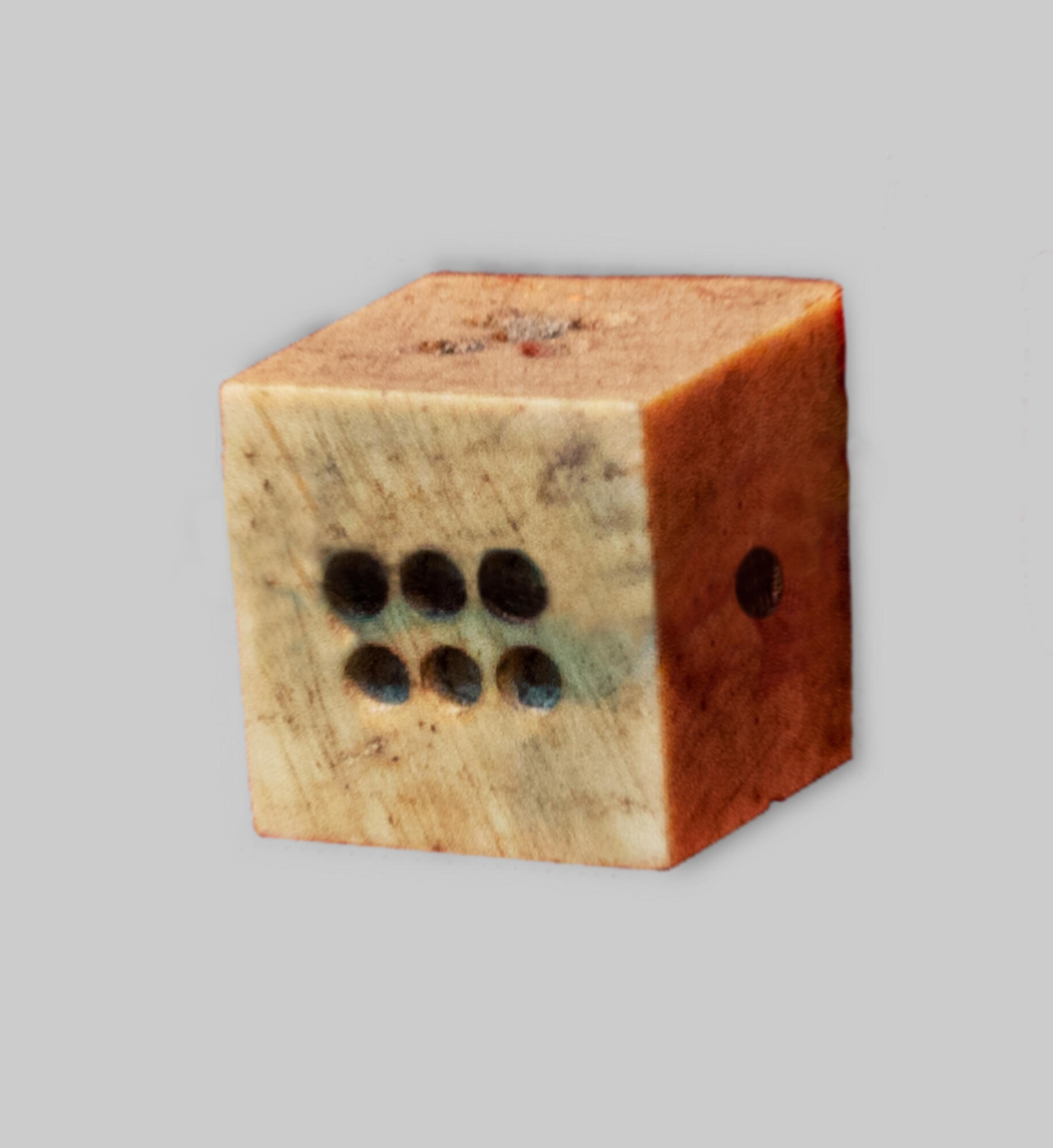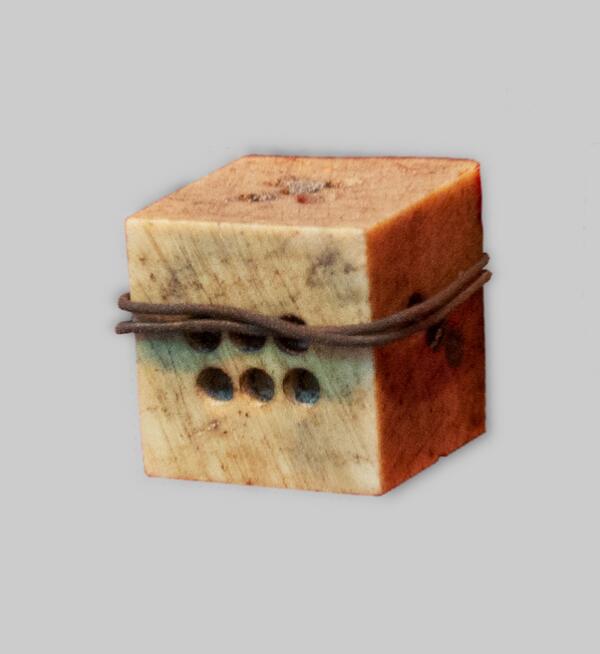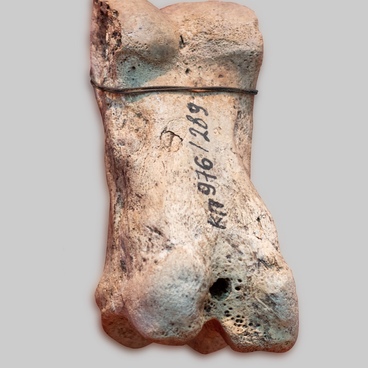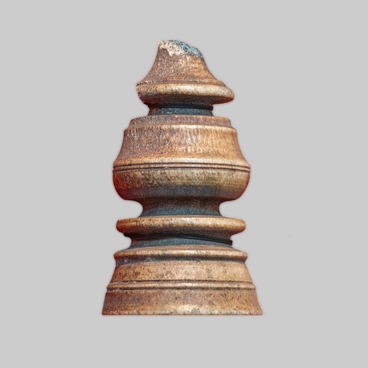During the archaeological excavations in Kuznetsk ostrog, apart from household items, arts and crafts items, military items, game attributes were also found, including dice for ‘zern’ game, or crap shoot. The dice from the museum collection is made of bone and has very small, only 6.5 mm long faces. It is marked in accordance with the European standard where the sum of scores of opposite faces was equal to seven. It is very likely that such dice was used in the game of tricktrack, a table game with checkers and dice. As the researchers say, such dice could be easily hidden from the boss, or even smoothly swallowed.
Games of fortune were a popular entertainment of the Russian Siberians in XVII–XVIII centuries. The games attracted among both the first colonists and local people. Stakes were made in furs and animal skins, less frequently in money. Gambling continued despite the Government Order of 1648 banning ‘any demonic action, mocking and buffoonery with all kind of devilish playing “, including “zern”, cards, chess and “lodYgi” — chequers.
The first bans of gambles in Russia date back to 1280, later they were mentioned in church orders of XIV–XV centuries. Those measures were initiated by the church. Nevertheless, the games of chance continued to exist, and their number increased with new instances. Late in XVI century, playing cards were brought into Russia and they promoted the development of the games of chance. Simultaneously, the first orders were issued that limited gambling. In 1551, the Church And Land Council adopted a collection of decisions – a Book of One Hundred Chapters— now, not only the participants of the games of chance were subject to punishment but also the spectators present.
The system of gambling control aimed at replenishing the treasury coffers was first established by Boris Godunov, who actually reigned the country since 1587. Mikhail Romanov maintained the system of fines and introduced the system of taxes and farming out the games of chance: playing cards, dice, chess and egg fights were farmed out to local authorities at the established rates in each city, “chet” (region) or “uyezd”(district).
The Code of Law dated 1649 classified the illegal games of chance as particularly grave crimes, in respect of which the offenders were sentenced to “signing the property away to the czar, whipping and cropping”, and later, to cutting off fingers and hands/arms. The games of chance were condemned at various tiers of power but the games were never forbidden as the state gained profit accurately from importing playing cards and farming. In those times taverns, fairs and pubs became the first Russian “casinos”.
In the upper society the games of chance appeared at the court of Peter the Great who did not welcome them but did not forbid either. Banning only remained in relation to money stakes above one rouble in copper – the principal enjoyment of gamblers. And in 1696 Peter I signed His Imperial Majesty Edict of strict prohibitive rules in relation to games of chance, especially for the military persons. Police checked all suspicious houses where gambling could take place. The attitude of ordinary people to gambling was hostile.
Nevertheless, farming out of crap and playing cards was resumed in XVIII century. The spread of games of chance resulted in another Edict of Peter I in 1717 prohibited gambling in wartime, and gambling away individual equipment and weapons. At the same time, the first lotteries appeared to replace the games of chance, the former being widely advertised among the population.
Games of fortune were a popular entertainment of the Russian Siberians in XVII–XVIII centuries. The games attracted among both the first colonists and local people. Stakes were made in furs and animal skins, less frequently in money. Gambling continued despite the Government Order of 1648 banning ‘any demonic action, mocking and buffoonery with all kind of devilish playing “, including “zern”, cards, chess and “lodYgi” — chequers.
The first bans of gambles in Russia date back to 1280, later they were mentioned in church orders of XIV–XV centuries. Those measures were initiated by the church. Nevertheless, the games of chance continued to exist, and their number increased with new instances. Late in XVI century, playing cards were brought into Russia and they promoted the development of the games of chance. Simultaneously, the first orders were issued that limited gambling. In 1551, the Church And Land Council adopted a collection of decisions – a Book of One Hundred Chapters— now, not only the participants of the games of chance were subject to punishment but also the spectators present.
The system of gambling control aimed at replenishing the treasury coffers was first established by Boris Godunov, who actually reigned the country since 1587. Mikhail Romanov maintained the system of fines and introduced the system of taxes and farming out the games of chance: playing cards, dice, chess and egg fights were farmed out to local authorities at the established rates in each city, “chet” (region) or “uyezd”(district).
The Code of Law dated 1649 classified the illegal games of chance as particularly grave crimes, in respect of which the offenders were sentenced to “signing the property away to the czar, whipping and cropping”, and later, to cutting off fingers and hands/arms. The games of chance were condemned at various tiers of power but the games were never forbidden as the state gained profit accurately from importing playing cards and farming. In those times taverns, fairs and pubs became the first Russian “casinos”.
In the upper society the games of chance appeared at the court of Peter the Great who did not welcome them but did not forbid either. Banning only remained in relation to money stakes above one rouble in copper – the principal enjoyment of gamblers. And in 1696 Peter I signed His Imperial Majesty Edict of strict prohibitive rules in relation to games of chance, especially for the military persons. Police checked all suspicious houses where gambling could take place. The attitude of ordinary people to gambling was hostile.
Nevertheless, farming out of crap and playing cards was resumed in XVIII century. The spread of games of chance resulted in another Edict of Peter I in 1717 prohibited gambling in wartime, and gambling away individual equipment and weapons. At the same time, the first lotteries appeared to replace the games of chance, the former being widely advertised among the population.



